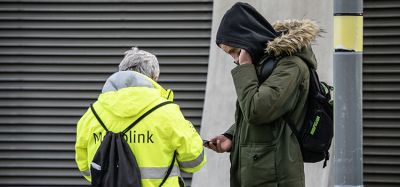A look at CCTV in Dublin
- Like
- Digg
- Del
- Tumblr
- VKontakte
- Buffer
- Love This
- Odnoklassniki
- Meneame
- Blogger
- Amazon
- Yahoo Mail
- Gmail
- AOL
- Newsvine
- HackerNews
- Evernote
- MySpace
- Mail.ru
- Viadeo
- Line
- Comments
- Yummly
- SMS
- Viber
- Telegram
- Subscribe
- Skype
- Facebook Messenger
- Kakao
- LiveJournal
- Yammer
- Edgar
- Fintel
- Mix
- Instapaper
- Copy Link
Posted: 6 October 2007 | Brendan O’Brien, Head of Technical Services (Traffic), Dublin City Council | No comments yet
Dublin City Council is a major user of CCTV systems. It is primarily used for traffic monitoring and management within the city area, along regional and motorway links, dedicated public transport links, and the approaches to the Dublin Port Tunnel.
The City Council monitors over 160 CCTV cameras from a 24-hour control centre situated close to the city centre. The video images from these cameras are shared with a number of other agencies within the Greater Dublin area, including surrounding local authorities, the police and emergency services, and the National Roads Authority.
Dublin City Council is a major user of CCTV systems. It is primarily used for traffic monitoring and management within the city area, along regional and motorway links, dedicated public transport links, and the approaches to the Dublin Port Tunnel. The City Council monitors over 160 CCTV cameras from a 24-hour control centre situated close to the city centre. The video images from these cameras are shared with a number of other agencies within the Greater Dublin area, including surrounding local authorities, the police and emergency services, and the National Roads Authority.
Dublin City Council is a major user of CCTV systems. It is primarily used for traffic monitoring and management within the city area, along regional and motorway links, dedicated public transport links, and the approaches to the Dublin Port Tunnel. The City Council monitors over 160 CCTV cameras from a 24-hour control centre situated close to the city centre. The video images from these cameras are shared with a number of other agencies within the Greater Dublin area, including surrounding local authorities, the police and emergency services, and the National Roads Authority. Dublin City Council has installed a high speed Ethernet ring on the motorway and approach roads, but has chosen to use digital uncompressed video transmission networks for the CCTV and traffic signals in the city, rather than use compressed video. While some installations of CCTV over IP have taken place, the policy is to utilise uncompressed video in order to provide the images back to the control centre so that, as far as possible, the images are available for further transmission or conversion as required. Dublin City Council has also started to invest in the provision of fibre optic routes throughout the city and along the motorway network. This has been done for a variety of reasons:
- Cost of leased telecom lines for CCTV use and the cost of annual fees for traffic signal controllers, as well as delays in completing installations.
- Development of quality bus network and the requirement that all Quality Bus Corridor (QBC) routes should have CCTV coverage for monitoring purposes.
- Development of the light rail network and the additional requirements of tram priority at 40 locations.
- Building of the Dublin Port Tunnel and the requirements for Heavy Goods Vehicle (HGV) management.
What type of transmission system is required for good CCTV management?
An analogue system similar to that in operation in the city centre for some years was initially assessed, but this involved using a large number of cores, and the distance (even for single mode units) was at the limit of the optical bandwidth. While this type of system had been in operation since the late 1980s, it was not a managed transmission system and it offered no resilience in terms of equipment failure. As such, it was felt that it could not meet the needs of motorway monitoring and the 24-hour requirements that arise from this type of operation. The other important consideration of this type of system was that it offered no serial or Ethernet ports. Types of equipment to be supported by this system:
- CCTV capable of expanding up to 200 cameras.
- Links to other control centres.
- In excess of 750 traffic signal controllers.
- Video detection systems.
- HGV counters.
- Variable message signs for motorway and urban routes.
- Bus priority measures.
- Other ITS systems as required.
One solution for this diverse range of applications would be to use an Etherent network solution; particularly for the motorway and regional link roads. For the majority of ITS applications to be supported, an IP network was installed on the M5 motorway with Cisco switches connected in a dual redundant ring. The Gibic interfaces for the switches provided a 1 Gigabyte backbone while providing 16 10/100 ports at each interchange. This network was extended to the M1 and the M50 approach roads by the use of Wireless IP switches. The schematic shows the variety of servers, switches and dedicated firewalls that are necessary in order to set-up this type of system. This network provides the links to other agencies and to the web services, as well as providing the necessary routing to the engineering and control centre workstations. However, in the course of this design, a fundamental decision had to be taken as to whether the traffic camera should use this network. It was clear that a digital transmission system was the only one that would provide the necessary drop and insert capability. This allows for the re-generation of any signals, and so overcomes problems with distances. Two options were looked at:
- Use an IP network with video compression.
- Digital uncompressed video over separate drop and insert circuits.
Network CCTV
The development of video compression technology, and the resulting reduction of the bandwidth required for transmission, have made possible the use of Ethernet or ATM networks for CCTV transmission. However, this type of system does have a number of drawbacks that must be realistically assessed when determining the type of system to implement. For CCTV monitoring, the basic requirements could be summed up as follows:
- Always on CCTV with no switch delay during camera selection.
- Multiple operators and agencies require access without degradation of the images.
- As close as possible to zero latency when operating the Pan Tilt and Zoom (PTZ) controls.
- Allows the use of video analysis software.
- Operator fatigue if images are not high quality.
A traffic application, particularly a motorway one, means that there is constant motion within the video image. The operator must be able to zoom in on a problem area, and this will mean that whichever compression technique is utilised, it must be able to deal with a large amount of pixel changes from one image to another. During the compression process, some information within the video signal is discarded. Therefore, this information cannot be retrieved if off-line analysis is required. In effect, this means that the demands of the compression methodology and any bandwidth limitations have more bearing on the received video than any inherent video requirements. The use of CCTV for urban and motorway control provides for the following:
- Speedy response to any incidents.
- Monitoring of, and adjustment to, operation of traffic signals.
- Bus lane monitoring.
- Roadworks control.
- Vehicle tracking.
- Driver information systems.
Video compression
In order to transmit CCTV images over a network, some form of compression is needed. Compression can reduce the bandwidth requirements from around 25Mb per second to 64Kb per second, depending on the video requirements and the bandwidth available. The various types of video compression available include:
- MPEG 2
- MPEG 4
- H263
- H264
- Wavelet
- MJPEG
- MJPEG 2000
Video compression attempts to discard any information which is not necessary for the viewing of the final image. Typically, the compression algorithm would be looking at changes within a frame, and also from frame to frame. As the scene content increases – as in the case of a high speed motorway – the bandwidth requirements also increase. The more active the monitoring of a motorway and the more an operator uses a camera, the more the bandwidth increases. Also, more operators or agencies requiring access to the images will, in general, increase the overall network bandwidth that needs to be taken up by the CCTV transmission. These traditional limitations of CCTV over IP are well documented. However, for wide area monitoring of CCTV, there are several other limitations that need to be taken into account. If the delay between using a control and seeing the camera image respond is in excess of 250ms, it makes the system extremely difficult for an operator to use over an extended period. Using compression can result in latencies in excess of this figure at a time when it is least needed; for example in the case of an incident. The design of a network topology is crucial to how reliable the system is. However, this is not a trivial task. Indeed, for the number of cameras required in Dublin, it requires far greater expertise than a conventional network. An IP network has to be maintained and this is an overhead that needs to be taken into account. A very important factor is that the use of a distributed network over a long distance (as in the case of a motorway) throws up issues of security of the main network. However it is a requirement to have a highly skilled design and maintenance support for these systems that can cause the most problems, as traffic networks, by their nature, are 24-hour operations; and a failure of the system can occur at any time. The use of third party analysis software is a major factor for a traffic management system. Video detection systems require analysis of high quality images, and these will not work properly on a compressed video stream. This in turn means that the video detection system must be located beside the cameras in the field, requiring additional hardware and maintenance overheads.
Uncompressed Video Transmission networks
Digital uncompressed video transmission using drop and insert circuits has the benefits of standard network capabilities, but does not compromise the video; except that which occurs when any analogue signal is converted to a digital one. However, the effects of this can be limited by choosing a sufficiently high number of quantisation bits. A drop and insert circuit is simply a daisy chain of transmission nodes, where each unit is connected typically by one or two fibres. At each node a number of video channels can be inserted, and this can vary from a single channel upwards, thereby making it particularly useful for traffic monitoring. The use of this technology means that a transmission ring can be put in place that provides redundancy, but does not require any network skills to be put in place. In the event of a failure of a node, the ring can self heal, ensuring that the other CCTV inputs are unaffected. The repair of the node is a simple replacement and configuration of the channel numbers. This type of equipment also offers a network channel and serial ports. This means that it is possible to connect traffic controllers and IP devices on to these devices, thus maximising the use of the transmission equipment. A typical configuration is shown here, where eight channels of video are provided; two at each location as well as an Ethernet capability and serial ports. The network developed is a managed system using Simple Network Management Protocol (SNMP), allowing connection to the main Fault Management System for automatic notification of loss of video, data, or node failure.
Public Transport
CCTV has a vital role to play in the operation of the light rail system in Dublin, both from a traffic management aspect as well as the important role of public safety. All of the light rail stops in Dublin are monitored by CCTV, and on Quality Bus Routes (QBR), the extensive CCTV coverage along the routes is shared with the police, in order to increase public safety. The digital uncompressed video transmission system on Quality Bus Corridor (QBC) routes is now planned to be extended. This will enable the provision of Real Time Passenger Information at bus stops; making use of the Ethernet capability of these units, as well as the existing journey time information regarding bus routes that is collected by using number plate recognition equipment.
Conclusion
When considering CCTV systems for applications such as urban and motorway use, it is important to ensure that the transmission system used does not have adverse consequences for the future. If the incorrect medium is chosen, it could seriously limit the quality of CCTV images displayed. To date, Dublin City Council’s experience has been that it is better to ensure that whatever network is chosen, it can deliver a high quality video image back to a control centre; and from there, it may be converted to network video, and stored or distributed as required.







